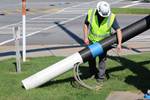Exel secures design patent extension for pultruded fiberglass radomes
Technique for antenna radomes forms “functional zones” inside composite material, enhancing existing 5G technology performance, application potential.
Exel Composites (Vantaa, Finland) has secured an extension to a design patent in Finland for its pultruded fiberglass antenna radomes. The move broadens the company’s intellectual property (IP) to include a novel, discontinuous technique that incorporates a range of functional zones in the radomes. This design is optimized for all frequency bands used in millimeter wave (mmWave) telecommunications. As well as enhancing the performance of existing 5G technology, the layered manufacturing technique also improves structural possibilities for other industries such as transportation and construction.
The previous iteration of Exel Composites’ patent covered radomes featured signal windows to enable uninterrupted transmission. The company’s recently developed and patented technology adds discrete material elements to form “functional zones” inside the material. These functional zones can be reinforced structural parts, insulating sections and radio frequency (RF) transparent areas, among others. Exel achieves these zones by sandwiching different materials such as RF-transparent foam in a fiberglass skin. This method optimizes the skin’s thickness and distance from the foam core to minimize signal loss and reflection.
Previously, when the profiles were cut from the continuous output, their edges were exposed to humidity. Exel’s novel technique, however, applies additional reinforcement to the areas that will be cut; therefore the foam inside is protected from moisture as well as impact damage.
Exel adds that these additions further optimize the composite material’s properties. Glass fiber profiles have optimal longitudinal stiffness. Bonding transverse directional stiffeners on top of the profile would make the end product heavier, but this new ability to add additional internal strengthening material negates that problem.
“Pultrusion, a continuous manufacturing technique, is ideal for large and/or wide profiles. It has always been flexible, capable of producing different 2D shapes,” explains Tiina Uotila, technical sales manager at Exel Composites and the inventor of this type of pultrusion for radomes. “Now, this development shows progress in pultrusion’s use for multilayered designs.
“The signal windows can be tailored to any frequency and, with our new technique, we can balance transmission demands with structural reinforcement and thermal and electrical insulation,” continues Uotila. “This capacity to add discrete elements to composite profiles of different shapes, textures and sizes, opens up countless new manufacturing options. I encourage our customers to approach us to test ideas in their own industries.”
Exel Composites will register this patent worldwide in active markets. Beyond telecommunications, the company intends to market this sandwich technology in other industries. For example, this complex profile type can give RF transparency to lightweight, rigid bus panels and insulating building materials in new developments.
Related Content
-
Biocomposite for mobile architecture, low load-bearing applications
The German Institutes of Textile and Fiber Research and partners have developed a biocomposite well suited for support profiles and connecting nodes in construction applications.
-
Pultrusion, pull-winding showcase high-volume composites production
JEC World 2024: Exel Composites offers attendees a chance to engage with company experts and learn more about continuous composite manufacturing processes across various industries.
-
FST-rated thermoset resin with rapid, tunable cure is designed for infusion
CAMX 2023: The nonhalogenated Harp Rapid resin system presented by Trimer Technologies achieves a low-temperature, tunable cure while attaining high mechanical properties, demonstrating its effectiveness in aerospace applications.
















